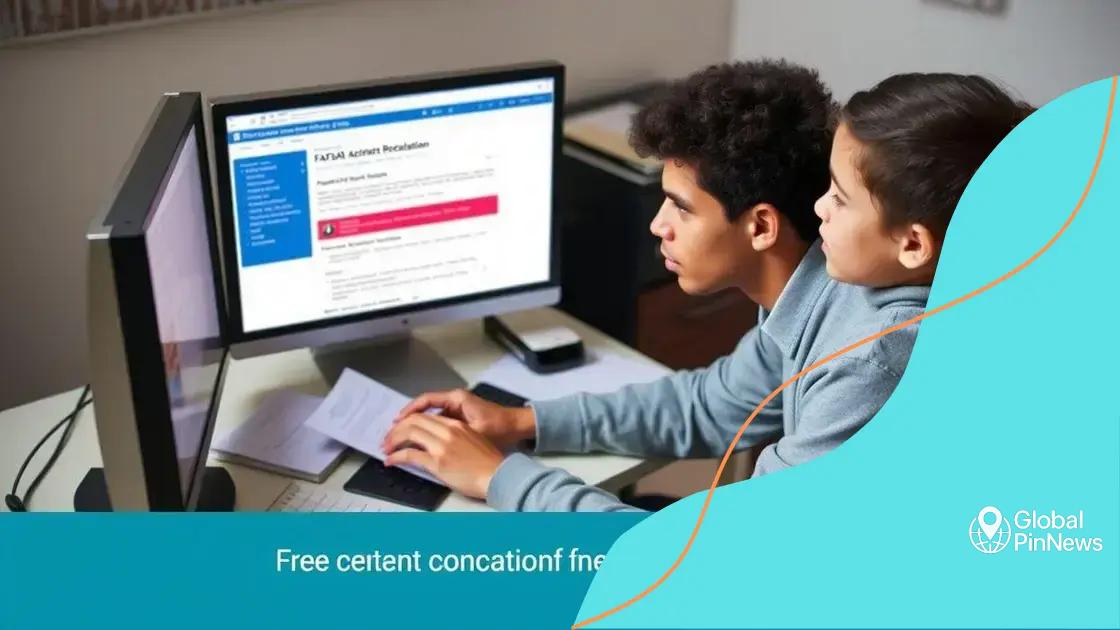Updates on FAFSA simplification: what you need to know

Updates on FAFSA simplification streamline the application process by reducing questions and improving accessibility to maximize student financial aid opportunities.
Updates on FAFSA simplification are changing the landscape of how students secure financial aid for college. With these changes, you might wonder how they will affect your journey to higher education. This article dives into what these updates mean for you.
Understanding the changes in FAFSA
Understanding the changes in FAFSA is crucial for students seeking financial aid. These updates aim to streamline the process, making it easier for families to apply for college funding.
One significant change is the simplification of the application form. This means fewer questions and clearer instructions, helping students complete their forms faster and with less confusion. The goal is to increase accessibility for all families.
Key Changes to Note
Here are some of the most important updates to keep in mind:
- The elimination of certain tax questions
- Changes in how family income is assessed
- New eligibility requirements for grants
Another important aspect of the FAFSA changes is the use of real-time data. This approach allows the FAFSA to pull in necessary information directly from tax databases. By doing this, students will spend less time providing documentation and can focus on other aspects of their education.
In addition, the simplification also addresses the needs of dependent students. Many will find that their financial aid eligibility is determined more fairly, based on their actual financial situations rather than outdated criteria. This is a big step toward ensuring equitable access to education.
The Impact on Students
These changes aim to positively affect students by increasing the number of applicants and, in turn, the amount of financial aid available. By reducing barriers, students from all backgrounds can have the opportunity to pursue higher education without the burden of financial stress.
Overall, the updates mean more students can access the funding they need. Understanding how to navigate these changes will empower students to make informed decisions regarding their education. The FAFSA simplification process represents a new chapter in making college more achievable for everyone.
How simplification impacts student aid eligibility
Understanding how simplification impacts student aid eligibility is essential for many families. Recent changes aim to create a fairer and more straightforward process for students seeking financial support. This means that many eligible students will find it easier to apply and receive the aid they need.
One of the major changes affecting eligibility is the reduction in the complexity of the application form. By asking fewer questions, the FAFSA allows students to streamline their applications. This is a significant relief for many who may have felt overwhelmed by the previous requirements.
Key Factors Influencing Eligibility
Several factors play a crucial role in determining student aid eligibility under the new simplified process:
- Income thresholds have been updated, making it easier for some families to qualify.
- Family contributions will be assessed more equitably based on current financial situations.
- Dependents will be considered differently, providing more accurate aid assessments.
In many cases, students and their families may not realize that they qualify for aid simply because of outdated information or assumptions. With the new system, potential applicants are encouraged to reconsider their eligibility.
The simplification also addresses specific financial situations that previously may not have been considered. For example, changes account for significant expenses or unusual circumstances that affect a family’s ability to pay for college. This ensures that support really reflects individual needs.
Encouraging More Applicants
By improving the clarity of the process and understanding of eligibility, more students are likely to apply. This can lead to increased access to education for diverse populations, creating a more equitable system. When students recognize that support is available, they are more likely to pursue their academic goals.
As the simplification continues, ongoing education about these changes will help maximize student engagement. It’s important to stay informed and understand how these adjustments can benefit your personal educational journey.
Navigating the new application process

Navigating the new application process for FAFSA is now simpler than ever. The recent updates aim to guide students smoothly through the steps, making it easier for everyone to apply for financial aid.
One of the first changes you will notice is the streamlined form. The new version asks fewer questions, which helps to reduce confusion. You’ll find that many familiar questions have been removed, allowing for a quicker response time.
Steps to Follow
To successfully navigate the new application process, here are the steps you should follow:
- Gather relevant documents, like your Social Security number and tax information.
- Visit the official FAFSA website to access the application.
- Fill out the required sections carefully, checking for accuracy.
Once your application is submitted, you will receive a confirmation. This step is crucial as it indicates that your application is being processed. Understand that the deadlines for submitting your FAFSA may vary, so it’s essential to mark them on your calendar.
In addition to the changes in the form, utilizing the new resources provided can greatly help. FAFSA now offers chat support to assist with questions during the application process. Having this support can make the journey feel less daunting.
Common Mistakes to Avoid
As you navigate the application, be aware of potential pitfalls:
- Double-checking your information to avoid typos, especially in your Social Security number.
- Missing deadlines, which can prevent you from receiving aid.
- Failing to review the new eligibility requirements, which may differ from previous years.
Avoiding these mistakes can help your application go smoothly. Remember, the goal is to make the process as straightforward as possible, ensuring that you can focus on your education.
Common questions about FAFSA simplification
Many students and families have common questions about FAFSA simplification. Understanding these frequently asked questions can help ease concerns and clarify the new process for applying for financial aid.
One of the most asked questions is about what specific changes have been made to the application. Many users want to know which questions have been eliminated or changed. The simplified FAFSA no longer asks for certain tax and financial details, removing the confusion that these questions often caused.
FAQs Regarding FAFSA
Here are some common questions and answers:
- Will the new FAFSA be easier to fill out? Yes, the new form is designed to be more accessible, with fewer questions to increase efficiency.
- Do I still need to provide tax information? While some tax information is still required, many details have been reduced, making the process simpler.
- How can I find out if I am eligible for aid? You can check your eligibility based on the updated criteria. The simplified form is designed to make this clearer.
Another question often raised is about the impact on student eligibility. With simplification, many families will discover that they may qualify for financial aid even if they previously thought otherwise. This change is aimed at increasing the overall number of applicants.
Addressing Concerns
Some might also worry about meeting deadlines. The FAFSA has specific deadlines each school year, but it is important to remember that these remain consistent. Submitting your application early can ensure that you receive the best possible aid package without rushing.
Families often wonder if they can still receive aid if there are changes in their financial situation. The good news is that students can update their FAFSA to reflect any changes that may affect their eligibility.
Tips for maximizing your financial aid
Maximizing your financial aid can significantly ease the burden of college expenses. There are several strategies that students and families can use to make the most of available resources.
One important tip is to fill out the FAFSA as early as possible. Submitting your application early ensures you are considered for the maximum amount of aid, as some funds are distributed on a first-come, first-served basis. Additionally, you should review your application for accuracy before submitting it. Mistakes can delay your financial aid and complicate your eligibility.
Understand Eligibility Requirements
Familiarizing yourself with eligibility requirements is crucial for receiving aid. Here are some key points to note:
- Be aware of how your family’s financial situation impacts your eligibility.
- Understand the different types of aid available, such as grants, loans, and work-study opportunities.
- Check for state-specific programs that may offer additional assistance.
Not all forms of aid are based solely on financial need. Some scholarships are awarded based on merit, such as academic achievements or extracurricular involvement. Therefore, pursuing a variety of funding sources can broaden your options.
Apply for Scholarships
Another effective way to maximize financial aid is to apply for scholarships. Many organizations and institutions offer funds that do not require repayment. Focus on scholarships that fit your profile. Here are some tips to enhance your scholarship applications:
- Tailor your essays to reflect the values and mission of the scholarship provider.
- Gather strong letters of recommendation from teachers or community leaders.
- Keep track of deadlines and required materials to ensure timely submissions.
Lastly, maintaining good academic standing can positively influence your financial aid prospects. Many scholarships require a minimum GPA to remain eligible for funding. So, staying on top of your studies is beneficial, not only for academics but also for securing ongoing financial support.
FAQ – Common Questions About FAFSA Simplification
What changes have been made to the FAFSA application?
The FAFSA application has been simplified by reducing the number of questions, making it easier for students to complete.
How can I maximize my financial aid?
You can maximize financial aid by applying early, gathering all required documents, and exploring scholarship opportunities.
Are there still deadlines for submitting the FAFSA?
Yes, the FAFSA has specific deadlines each year that you need to meet to be eligible for financial aid.
What should I do if my financial situation changes?
If your financial situation changes, you can update your FAFSA to reflect your current circumstances, which may affect your eligibility for aid.
